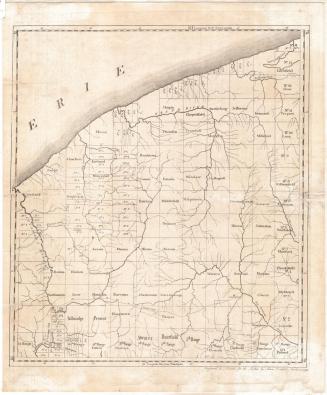A Plan of the Connecticut Western Reserve
MakerMade by
Unknown
SurveyorPossibly surveyed by
Seth Pease
(American, 1774 - 1819)
DraftsmanPossibly drawn by
Seth Pease
(American, 1774 - 1819)
Dateabout 1796
MediumDrawing; black ink and watercolor on laid paper
DimensionsPrimary Dimensions (image height x width): 20 x 17 7/8in. (50.8 x 45.4cm)
Sheet (height x width): 29 7/8 x 21 1/2in. (75.9 x 54.6cm)
ClassificationsGraphics
Credit LineConnecticut Museum of Culture and History collection
Object number2006.114.0
DescriptionManuscript map of the Connecticut Western Reserve in present-day Ohio, from Lake Erie to the north and the Cuyahoga River to the west. The land is divided into fourteen rows and eleven columns, both called "ranges," and the resulting squares, probably townships, contain numbers that probably refer to land measurements, as well as the owner's name, if known. Some of the squares are further divided into lots. Various unnamed rivers appear on the map, as well as broken solid and dotted lines that might represent paths or roads.
Label TextThe city of Cleveland was named after Moses Cleaveland of Brooklyn, Connecticut, a member of the Connecticut Land Company, which surveyed the Western Reserve and divided it into townships. Cleveland and the neighboring community of Euclid (named after the ancient Greek mathmetician) are both clearly shown on this early manuscript map. Some additional townships are marked with the names of property owners, including G. Granger, William Hart, Jesse Phelps and others, while many sections remain unassigned and available. In 1800, Connecticut's Western Reserve became part of the Northwest Territory. It was named Trumbull County after Connecticut Governor Jonathan Trumbull. In 1803, Trumbull County became part of the new state of Ohio.
NotesCartographic Note: No scaleStatus
Not on viewSamuel Augustus Mitchell
1834
Samuel Augustus Mitchell
1835













